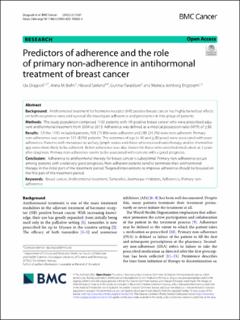| dc.contributor.author | Dragvoll, Ida | |
| dc.contributor.author | Bofin, Anna M. | |
| dc.contributor.author | Søiland, Håvard | |
| dc.contributor.author | Taraldsen, Gunnar | |
| dc.contributor.author | Engstrøm, Monica J | |
| dc.date.accessioned | 2023-01-12T09:48:53Z | |
| dc.date.available | 2023-01-12T09:48:53Z | |
| dc.date.created | 2022-12-13T14:21:27Z | |
| dc.date.issued | 2022 | |
| dc.identifier.citation | BMC Cancer. 2022, 22 . | en_US |
| dc.identifier.issn | 1471-2407 | |
| dc.identifier.uri | https://hdl.handle.net/11250/3042919 | |
| dc.description.abstract | Background
Antihormonal treatment for hormone receptor (HR) positive breast cancer has highly beneficial effects on both recurrence rates and survival. We investigate adherence and persistence in this group of patients.
Methods
The study population comprised 1192 patients with HR-positive breast cancer who were prescribed adjuvant antihormonal treatment from 2004 to 2013. Adherence was defined as a medical possession ratio (MPR) of ≥80.
Results
Of the 1192 included patients, 903 (75.8%) were adherent and 289 (24.2%) were non-adherent. Primary non-adherence was seen in 101 (8.5%) patients. The extremes of age (< 40 and ≥ 80 years) were associated with poor adherence. Patients with metastasis to axillary lymph nodes and those who received radiotherapy and/or chemotherapy were more likely to be adherent. Better adherence was also shown for those who switched medication at 2 years after diagnosis. Primary non-adherence seems to be associated with cancers with a good prognosis.
Conclusion
Adherence to antihormonal therapy for breast cancer is suboptimal. Primary non-adherence occurs among patients with a relatively good prognosis. Non-adherent patients tend to terminate their antihormonal therapy in the initial part of the treatment period. Targeted interventions to improve adherence should be focused on the first part of the treatment period. | en_US |
| dc.language.iso | eng | en_US |
| dc.publisher | BioMed Central | en_US |
| dc.rights | Navngivelse 4.0 Internasjonal | * |
| dc.rights.uri | http://creativecommons.org/licenses/by/4.0/deed.no | * |
| dc.title | Predictors of adherence and the role of primary non-adherence in antihormonal treatment of breast cancer | en_US |
| dc.title.alternative | Predictors of adherence and the role of primary non-adherence in antihormonal treatment of breast cancer | en_US |
| dc.type | Peer reviewed | en_US |
| dc.type | Journal article | en_US |
| dc.description.version | publishedVersion | en_US |
| dc.source.pagenumber | 12 | en_US |
| dc.source.volume | 22 | en_US |
| dc.source.journal | BMC Cancer | en_US |
| dc.identifier.doi | 10.1186/s12885-022-10362-4 | |
| dc.identifier.cristin | 2092612 | |
| cristin.ispublished | true | |
| cristin.fulltext | original | |
| cristin.qualitycode | 1 | |

